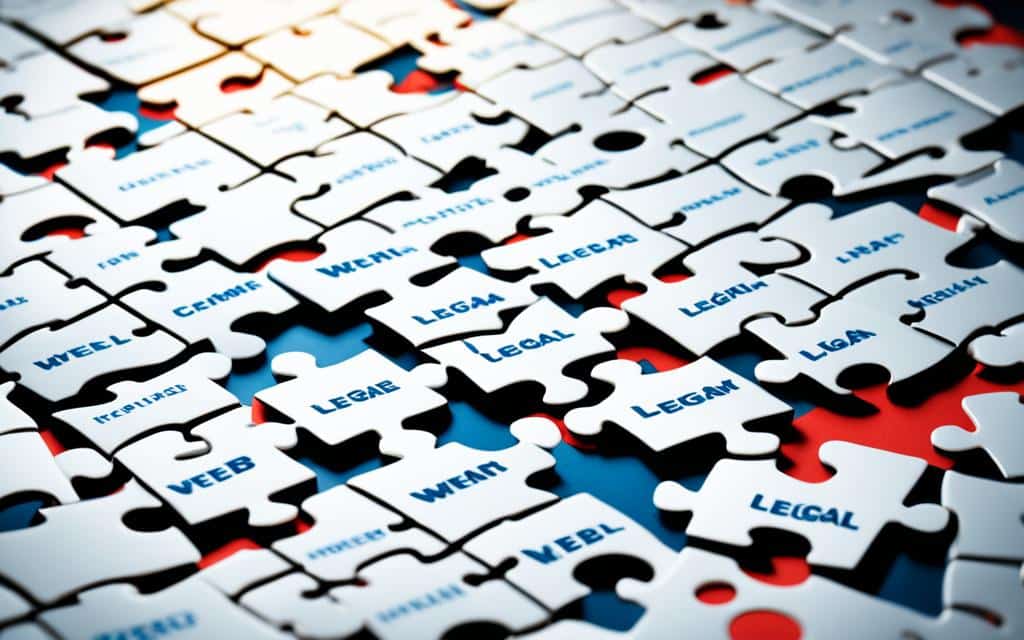Table of Contents
As the digital world continues to evolve, it is essential for organizations to ensure that their websites, apps, and platforms are accessible to all users, including those with disabilities. However, recent trends indicate a significant increase in legal actions related to web accessibility compliance. Failure to address these issues can result in costly lawsuits and damage to a company’s reputation.
Digital accessibility lawsuits have become a common occurrence, with individuals and advocacy groups seeking to enforce compliance with web accessibility standards. These lawsuits often target organizations that fail to make their digital platforms accessible to individuals with disabilities. However, it is important to note that the legal landscape of web accessibility is complex and continues to evolve.
Leading disability rights attorney, Eve Hill, highlights the constant volume of lawsuits and the lack of industry compliance. In addition, there is an emerging trend of lawsuits challenging the accessibility of overlays, which are commonly used to make websites accessible. New technology companies, including those producing extended reality (XR) and virtual reality (VR) experiences, are also being targeted for accessibility violations. This indicates that the scope of web accessibility lawsuits is expanding to encompass a wide range of technologies and industries.
Furthermore, organizations that receive federal funding or assistance face additional regulatory requirements. Impending regulations from the Department of Education and the Department of Health and Human Services are expected to impact these organizations and their obligations to ensure digital accessibility.
It is crucial for organizations to stay informed about the legal requirements and best practices regarding web accessibility. By proactively addressing these issues, businesses can not only avoid legal risks but also ensure equal access to their digital platforms for individuals with disabilities. In the following sections, we will explore the importance of digital accessibility, notable cases in web accessibility, the impact of regulations, the need for implementation, recent settlements, and guidelines provided by the Department of Justice.
The Importance of Digital Accessibility
Digital accessibility plays a vital role in ensuring equal access to the online world for individuals with disabilities. It encompasses the design and development of websites, apps, and other digital platforms to make them usable and navigable for people with visual, hearing, and motor impairments.
Companies that fail to prioritize digital accessibility may find themselves facing legal repercussions. Accessibility overlays, which were once considered a solution for improving accessibility, are now being challenged as ineffective by individuals filing lawsuits. These overlays, which claim to automatically make websites accessible, often provide a subpar user experience and do not meet the required standards.
In addition to overlays, emerging technology companies are also under scrutiny for accessibility violations. Extended reality (XR) and virtual reality (VR) experiences, while immersive and innovative, often fail to address accessibility needs. As these technologies become more prevalent, it is crucial for companies to consider accessibility from the outset to avoid legal issues and exclusionary practices.
Ensuring Inclusive Digital Experiences
Creating digital experiences that are inclusive and accessible involves adopting best practices and compliance with accessibility standards. The Web Content Accessibility Guidelines (WCAG) provide detailed guidance on making websites and digital platforms accessible to all users, regardless of their abilities. By adhering to WCAG and investing in inclusive design and development, companies can ensure they are not only meeting legal requirements but also creating an inclusive online environment that welcomes and accommodates individuals with disabilities.
Implementing digital accessibility measures benefits not only individuals with disabilities but also the business itself. A more inclusive and accessible digital presence can lead to increased customer satisfaction, improved user engagement, and expanded market reach. By embracing accessibility, companies demonstrate their commitment to equality and social responsibility, fostering a positive brand image and differentiation in the market.
“Accessibility is a human right.” – Tim Berners-Lee
Tim Berners-Lee, the inventor of the World Wide Web, recognized the importance of accessibility as a fundamental human right. He believed that the web should be accessible to all individuals, regardless of their abilities. In his vision, digital accessibility removes barriers and empowers individuals to fully participate in the digital age, unlocking opportunities and enriching lives.
| Benefits of Prioritizing Digital Accessibility |
|---|
| 1. Enhanced user experience for all users, promoting inclusivity. |
| 2. Compliance with legal requirements and avoidance of accessibility-related lawsuits. |
| 3. Improved brand reputation and differentiation in the market. |
| 4. Expanded customer base and increased market reach. |
| 5. Positive impact on SEO, as search engines prioritize accessible websites. |
Remember, digital accessibility goes beyond compliance; it is about creating an inclusive and welcoming digital landscape for all individuals.
Notable Cases in Web Accessibility
Several notable cases highlight the ongoing struggle for web accessibility. These cases exemplify the consequences and challenges faced by organizations failing to prioritize digital inclusion. They provide insights into the legal landscape surrounding web accessibility and its implications for Section 508 compliance and ADA Title III lawsuits.
“The Orozco v. Garland case established that federal employees have a private right of action to sue for Section 508 violations.”
In the Orozco v. Garland case, the ruling affirmed the rights of federal employees to take legal action against their employers for Section 508 violations. This landmark case sets an important precedent for individuals seeking recourse for inaccessible digital platforms and serves as a reminder to organizations of their legal obligations regarding web accessibility.
“Acheson Hotels v. Laufer is set to determine the standing of accessibility testers in filing lawsuits.”
The Acheson Hotels v. Laufer case addresses the standing of accessibility testers to file lawsuits for web accessibility violations. This case aims to clarify the role of third-party testers in identifying accessibility barriers and enforcing compliance. The outcome of this case will have significant implications for accessibility advocacy and enforcement efforts in the future.
These notable cases shed light on the complexities and ambiguities surrounding web accessibility lawsuits. They underscore the need for clear guidelines and legal frameworks to ensure the equal rights and access of individuals with disabilities in the digital realm.
Notable Web Accessibility Cases
| Case | Description |
|---|---|
| Orozco v. Garland | Affirmed the right of federal employees to sue for Section 508 violations. |
| Acheson Hotels v. Laufer | Addresses the standing of accessibility testers in filing lawsuits for web accessibility violations. |
| … | … |
The Impact of Regulations on Web Accessibility
As digital accessibility continues to gain importance, government agencies are taking steps to ensure that websites and digital platforms are accessible to all users, including those with disabilities. The Department of Education and the Department of Health and Human Services have been working on regulations to enforce digital accessibility under Section 504 of the Rehabilitation Act. These regulations are specifically targeted towards organizations that receive federal funding or assistance, such as universities and hospitals.
In addition, the Justice Department (DOJ) is planning to release regulations on web accessibility for state and local governments under Title II of the ADA. This means that not only public-sector entities but also private-sector organizations should pay attention to these regulatory developments, as they may set the standards for website accessibility compliance across various sectors.
By implementing these regulations, organizations can ensure that their websites and digital platforms are accessible to people with disabilities, providing equal opportunities for all individuals to access information and services online.
The Need for Web Accessibility Implementation
Ensuring compliance with accessibility laws and standards is paramount in implementing web accessibility. Organizations must adhere to the Web Content Accessibility Guidelines (WCAG) to make their websites accessible to all users. These guidelines offer detailed guidance on how to achieve web accessibility and create an inclusive online experience.
Implementing web accessibility measures requires a deep understanding of the legal framework surrounding accessibility. By staying proactive and taking proactive steps, organizations can avoid potential legal issues and create an environment that caters to individuals with disabilities.
“Web accessibility implementation is not only a legal requirement but also a moral and ethical responsibility. It empowers individuals with disabilities to access information, services, and opportunities that others enjoy. Every step taken towards accessibility brings us closer to a more inclusive digital landscape.”
To ensure successful implementation, organizations should prioritize the application of the WCAG’s principles and success criteria. These include:
- Perceivability: Providing alternatives for non-text content, ensuring content is distinguishable, and using adaptable and consistent presentation.
- Operability: Making functionality available through different input methods and providing clear navigation mechanisms.
- Understandability: Making content readable and understandable and providing assistance with error prevention and correction.
- Robustness: Creating robust content by using valid, well-structured markup to ensure compatibility with different user agents.
Organizations can use various tools, both automated and manual, to evaluate and maintain web accessibility. Automated accessibility checkers can assist in identifying common accessibility issues, while manual auditing helps identify complex issues that may require individual attention.
By implementing web accessibility, organizations not only comply with accessibility laws but also create a more inclusive and engaging user experience for all individuals.
| Benefits of Web Accessibility Implementation | Challenges of Web Accessibility Implementation |
|---|---|
| Enhanced user experience for individuals with disabilities | Understanding and interpreting complex accessibility guidelines |
| Expanded reach and potential customer base | Ensuring accessibility across various platforms and devices |
| Improved SEO and search engine visibility | Allocating resources for accessibility implementation |
| Legal compliance and risk mitigation | Awareness and education within the organization |
Recent Settlements and DOJ Guidance
The Department of Justice (DOJ) has been actively involved in settling a number of high-profile website accessibility cases, underscoring the significance of complying with ADA Title III. These settlements have specifically targeted inaccessible vaccine scheduling portals, prompting non-monetary agreements between the government and the businesses implicated. By prioritizing website accessibility, organizations can avoid legal consequences and ensure equitable access for individuals with disabilities.
The DOJ has also released guidance on website accessibility, addressing businesses open to the public under ADA Title III. This guidance serves as a valuable resource for organizations seeking clarity on their obligations and best practices for creating accessible websites. By following these guidelines, businesses can proactively implement accessibility measures and avoid potential legal issues in the future.
| Date | Case | Parties Involved | Settlement Terms |
|---|---|---|---|
| July 2021 | Rose v. Large Retailer | Rose (Plaintiff), Large Retailer (Defendant) | Defendant agrees to remediate website accessibility issues, conduct regular accessibility audits, and provide accessibility training to web development staff. |
| November 2020 | Smith v. Travel Booking Company | Smith (Plaintiff), Travel Booking Company (Defendant) | Defendant commits to improving website accessibility, implementing an accessibility policy, and ensuring third-party vendors comply with accessibility standards. |
| March 2020 | Doe v. Healthcare Provider | Doe (Plaintiff), Healthcare Provider (Defendant) | Defendant agrees to make its website accessible, appoint an ADA coordinator, and provide accessibility training to employees. |
Recent website accessibility settlements demonstrate that organizations must take proactive steps towards compliance with ADA Title III. By prioritizing accessibility and following DOJ guidance, businesses can ensure inclusive online experiences for all users and mitigate the risk of facing legal action.
The Impact of WCAG on Website Compliance
The Web Content Accessibility Guidelines (WCAG) are crucial in ensuring website compliance with accessibility standards. These guidelines provide comprehensive recommendations for making websites accessible to individuals with disabilities, ensuring equal access and usability for all users.
WCAG covers various aspects of accessibility, including:
- Color contrast: Ensuring sufficient contrast between text and background colors to improve readability for individuals with visual impairments.
- Text alternatives for images: Providing descriptive text alternatives for images, allowing screen readers to convey the information to visually impaired users.
- Synchronized video captions: Including captions that are synchronized with video content, making it accessible to individuals with hearing impairments.
- Keyboard navigation: Ensuring that all functionality on the website can be accessed and operated through a keyboard, enabling users with motor impairments to navigate effectively.
By adhering to WCAG, website owners can create an inclusive online environment that caters to users with disabilities. WCAG sets the benchmark for best practices in website accessibility and serves as a guide for designing and developing accessible websites.
To ensure WCAG compliance, organizations can utilize automated accessibility checkers and conduct manual auditing. Automated tools help identify common accessibility issues, while manual auditing enables in-depth examination to ensure all accessibility requirements are met.
“WCAG provides the foundation for creating websites that are accessible to all individuals, regardless of their abilities. By following the guidelines, organizations can demonstrate their commitment to inclusivity and ensure equal access for everyone.”
Implementing WCAG not only aligns with legal obligations but also promotes a positive user experience. Accessible websites have the potential to reach a larger audience and improve user satisfaction. By investing in web accessibility, organizations can foster inclusivity, boost their reputation, and uphold their commitment to creating an accessible digital environment.
Example Implementation Table
| WCAG Guideline | Description | Implementation Status |
|---|---|---|
| 1.4.3 Contrast (Minimum) | Ensuring sufficient color contrast between text and background | Implemented |
| 1.1.1 Non-text Content | Providing text alternatives for images | In progress |
| 1.2.2 Captions (Pre-recorded) | Adding synchronized captions to video content | Not implemented |
| 2.1.1 Keyboard | Enabling website functionality to be accessible via keyboard navigation | Implemented |
Conclusion
In conclusion, web accessibility is not only a legal requirement but also a critical aspect of creating an inclusive digital landscape. The increasing number of digital accessibility lawsuits highlights the importance of organizations prioritizing accessibility in their websites, apps, and platforms. With impending regulations on the horizon, organizations from various sectors will need to ensure compliance with accessibility laws and standards to mitigate legal risks.
Implementing web accessibility measures, such as adhering to the Web Content Accessibility Guidelines (WCAG), is essential for organizations to provide equal access to individuals with disabilities. It is crucial to consider aspects such as color contrast, text alternatives for images, video captions, and keyboard navigation in order to create an inclusive online environment. Automated accessibility checkers and manual auditing can help maintain website accessibility and prevent potential legal issues.
Ultimately, the web accessibility landscape is constantly evolving, and organizations must stay proactive in their efforts to prioritize the inclusion of individuals with disabilities in the digital world. By embracing web accessibility, organizations can not only mitigate legal risks but also enhance their overall user experience and demonstrate a commitment to inclusivity and equal access for all.
FAQ
What is web accessibility compliance?
Web accessibility compliance refers to the practice of making websites, apps, and other digital platforms accessible for individuals with disabilities. It involves ensuring that these platforms are usable and navigable for people with visual, hearing, and motor impairments.
Why is digital accessibility important?
Digital accessibility is important because it ensures equal access to the online world for individuals with disabilities. It allows them to fully participate in online activities, access information, and engage with digital services.
What are accessibility overlays?
Accessibility overlays are tools or plugins that claim to make websites accessible. However, they are currently being challenged as ineffective solutions in lawsuits filed against companies that use them.
Are emerging technology companies targeted in accessibility lawsuits?
Yes, emerging technology companies, such as those producing extended reality (XR) and virtual reality (VR) experiences, are also being targeted in accessibility lawsuits for violations of digital accessibility standards.
What are some notable web accessibility cases?
Some notable web accessibility cases include the Orozco v. Garland case, which established that federal employees have a private right of action to sue for Section 508 violations, and the Acheson Hotels v. Laufer case, which will determine the standing of accessibility testers in filing lawsuits.
How do regulations impact web accessibility?
Regulations from the Department of Education and the Department of Health and Human Services, as well as the planned regulations from the Department of Justice, will impact organizations receiving federal funding or assistance. These regulations set standards for web accessibility compliance.
Why is web accessibility implementation important?
Web accessibility implementation is important because it ensures compliance with accessibility laws and standards. Organizations must adhere to the Web Content Accessibility Guidelines (WCAG), which provide detailed guidance on making websites accessible.
What are the recent website accessibility settlements?
The Department of Justice (DOJ) has settled several high-profile website accessibility cases, focusing on inaccessible vaccine scheduling portals. These settlements emphasize the importance of complying with ADA Title III.
How do WCAG guidelines impact website compliance?
The Web Content Accessibility Guidelines (WCAG) play a significant role in ensuring website compliance with accessibility standards. Adhering to WCAG guidelines, such as color contrast, text alternatives for images, synchronized video captions, and keyboard navigation, is crucial for creating an inclusive online environment.
What is the conclusion of the web accessibility landscape?
Web accessibility is a legal requirement that organizations must address to avoid legal risks and ensure equal access for individuals with disabilities. It is crucial for organizations to implement web accessibility measures, comply with accessibility laws and standards, and prioritize the inclusion of individuals with disabilities in the digital world.













